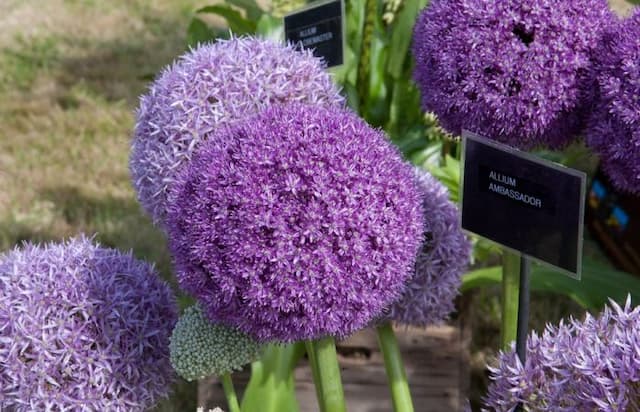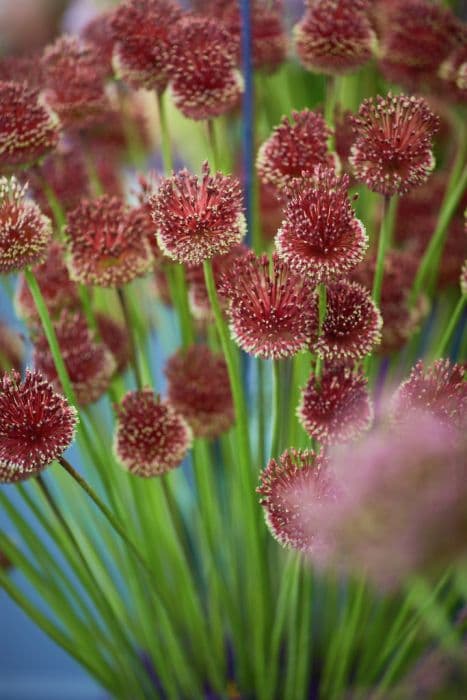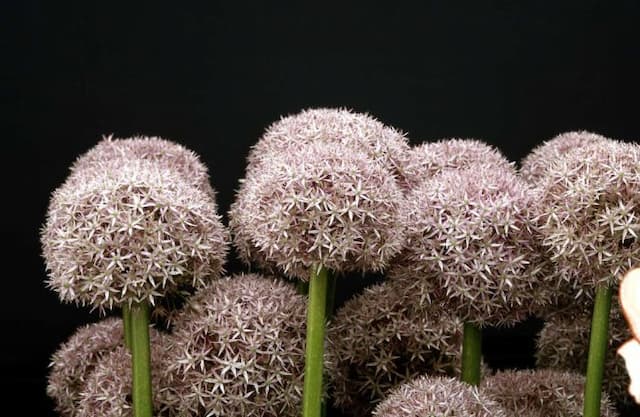Chameleon Allium Allium 'Caméléon'

ABOUT
Allium 'Caméléon' is a striking plant known for its ornamental appeal. It develops rounded clusters of star-shaped flowers that exhibit a blend of colors, often starting as one shade when the blooms are in bud and transforming to another as they mature—much like the adaptive color changes of a chameleon, hence the name. The delicate flowers usually display shades of pink, purple, and sometimes a hint of cream or green, creating a beautiful two-tone effect. The foliage of Allium 'Caméléon' consists of slender, strappy leaves that emanate from the base of the plant, forming a tuft of greenery at ground level. This leafy growth is generally a lush, deep green color, providing a contrasting backdrop to the vivid blooms held aloft on sturdy, upright stems. The leaves may also have a slight glaucous coating, giving them a somewhat silvery appearance. The flowering stems of 'Caméléon' rise above the foliage, bearing the floral spheres at their tips. The blossoms are tightly packed, giving the flower head a dense, compact look. Each tiny blossom contributes to the spherical shape, creating a visual spectacle akin to a fireworks display. In the right conditions, Allium 'Caméléon' could have an extended blooming period, providing a long-lasting display of color in the garden. The plant is appreciated for its visual charm and its ability to attract pollinators like bees and butterflies, which are drawn to its nectar-rich blooms. When not in flower, the architectural foliage of 'Caméléon' maintains interest, offering a structural element to garden beds or borders.
About this plant
 Names
NamesFamily
Amaryllidaceae
Synonyms
Chameleon Allium, Ornamental Onion
Common names
Allium 'Caméléon'.
 Toxicity
ToxicityTo humans
The Allium 'Caméléon', commonly referred to as an ornamental onion, is not considered highly toxic to humans. However, it may cause mild stomach upset if ingested in large quantities. This plant is from the Allium family, which includes onions, garlic, and chives, all of which can cause gastrointestinal irritation if consumed in excessive amounts. Symptoms of poisoning from eating significant amounts of ornamental onion might include nausea, vomiting, and diarrhea. It's usually not severe, but individuals with a sensitive stomach or those who consume a large amount of the plant might experience more discomfort.
To pets
Ornamental onion is toxic to pets, particularly dogs and cats, as it belongs to the Allium family, which also includes onions, garlic, and chives. The ingestion of any part of the plant can lead to symptoms such as gastrointestinal upset, elevated heart rate, lethargy, and potentially hemolytic anemia if consumed in large quantities. The toxicity stems from compounds in the plant that can cause damage to red blood cells, leading to symptoms such as pale gums, rapid breathing, weakness, or even collapse. If a pet ingests a significant amount of ornamental onion, it is recommended to seek veterinary care immediately.
 Characteristics
CharacteristicsLife cycle
Perennials
Foliage type
Deciduous
Color of leaves
Green
Flower color
Varies
Height
1-2 feet (30-60 cm)
Spread
0.5 feet (15 cm)
Plant type
Bulb
Hardiness zones
4
Native area
Europe
Benefits
 General Benefits
General Benefits- Aesthetic Appeal: Adds visual interest to gardens with its attractive pink-tinged white blooms.
- Pollinator Attraction: Attracts bees, butterflies, and other beneficial insects that aid in the pollination of nearby plants.
- Drought Tolerance: Once established, it requires minimal watering, making it suitable for dry climates or water-wise gardens.
- Easy Care: Requires minimal maintenance, making it a good choice for low-maintenance landscapes.
- Disease and Pest Resistance: Generally resistant to many common garden pests and diseases, reducing the need for chemical treatments.
- Multiplication: Propagates easily, allowing gardeners to expand their collection or share with others.
- Seasonal Interest: Provides late spring to early summer blooms, helping to bridge the gap between early spring and high summer flowering periods.
- Culinary Use: Edible parts can be used in cooking, adding flavor to a variety of dishes (do not consume without proper identification and knowledge).
- Longevity: Perennial nature means it can be a long-lasting addition to the garden, returning year after year.
 Medical Properties
Medical PropertiesThis plant is not used for medical purposes.
 Air-purifying Qualities
Air-purifying QualitiesThis plant is not specifically known for air purifying qualities.
 Other Uses
Other Uses- Photography Accent: Allium 'Caméléon' can be used by photographers as a striking, colorful focal point in garden and nature photography due to its vibrant blooms.
- Floral Design Element: Its unique shape and color make it a popular choice in contemporary floral arrangements and bridal bouquets for a touch of elegance.
- Educational Tool: Botany educators may use Allium 'Caméléon' as a living specimen to teach about plant biology, pollination, and the diversity of the onion family.
- Dye Production: The intense colors of the flowers can be used to create natural dyes for textiles, crafts, or even as food colorants.
- Artistic Inspiration: Artists may draw inspiration from the form and color of Allium 'Caméléon', incorporating its image into paintings, illustrations, and sculptures.
- Theme Gardens: This plant is perfect for creating a 'chameleon' themed garden, showcasing plants that have properties of changing or blending into their surroundings.
- Culinary Decoration: Although not commonly consumed, the flowers can be used as an edible decoration to add a splash of color to gourmet dishes.
- Garden Borders: Due to its upright growth habit, Allium 'Caméléon' can be planted to create vivid borders along walkways or garden beds.
- Living Fences: When planted in dense rows, these plants can form a semi-permanent, living barrier that adds privacy as well as aesthetic appeal to garden spaces.
- Companion Planting: Because of its reputed ability to deter certain pests, Allium 'Caméléon' is often planted near Rose gardens or vegetable plots to protect more vulnerable plants.
Interesting Facts
 Feng Shui
Feng ShuiThe Allium, commonly known as ornamental onion, is not specifically used in Feng Shui practice.
 Zodiac Sign Compitability
Zodiac Sign CompitabilityThe Allium, commonly known as ornamental onion, is not used in astrology practice.
 Plant Symbolism
Plant Symbolism- Persistence - Alliums, also known as ornamental onions, are resilient plants, often symbolizing durability and the will to continue despite challenges.
- Unity - With their globe-shaped clusters of flowers, alliums can represent unity, as the individual blooms come together to form a complete sphere.
- Good Fortune - In some cultures, alliums are thought to bring luck, probably because of their eye-catching and unusual flower heads.
- Humility - Despite their impressive appearance, alliums grow from humble beginnings in the soil, which can symbolize modesty and humbleness.
- Strength - Alliums have tall, sturdy stems, symbolizing strength and the ability to stand tall in the face of adversity.
 Water
WaterOrnamental onions should be watered thoroughly once a week, with the amount of water adjusted depending on seasonal rainfall and temperatures. During the active growing season in spring and early summer, ensure that the soil is kept consistently moist but not waterlogged. An inch of water per week, including rainfall, is generally adequate. In the summer's hotter, drier periods, increase the watering frequency to prevent the soil from drying out completely, but always allow the soil to dry slightly between waterings. Reduce watering after the flowering period as the plant's foliage begins to die back, and during the dormant season, minimal watering is necessary.
 Light
LightOrnamental onions thrive best in full sunlight conditions. They should be planted in a location that receives at least 6 hours of direct sunlight daily for optimal growth and flowering. These plants are well-suited for sunny borders or open areas where they can receive unfiltered sunlight throughout the day.
 Temperature
TemperatureOrnamental onions prefer a temperature range between 55°F to 75°F, which is ideal for their growth. They are able to tolerate a minimum temperature down to about 28°F and can survive brief periods of colder temperatures. While they can handle some heat, extended periods above 90°F may stress the plants.
 Pruning
PruningOrnamental onions should be pruned to remove spent flower heads to encourage the plant to direct its energy towards bulb development and next year's growth. The best time for pruning is when the flowers have faded but before seeds are set. Pruning is generally done yearly, after flowering.
 Cleaning
CleaningAs needed
 Soil
SoilChameleon Allium thrives best in well-drained soil with a pH ranging from 6.0 to 7.5. A mix of loam, sand, and compost will ensure good drainage and fertility. For container planting, a commercial potting mix amended with organic matter is suitable.
 Repotting
RepottingChameleon Allium typically does not require frequent repotting and can be done every 3-4 years. It is essential to repot if the bulbs become crowded or the soil is exhausted.
 Humidity & Misting
Humidity & MistingChameleon Allium prefers average humidity levels but is quite adaptable and will tolerate the lower humidity found in most homes.
 Suitable locations
Suitable locationsIndoor
Place Chameleon Allium in bright, indirect light.
Outdoor
Plant Chameleon Allium in full sun to partial shade.
Hardiness zone
4-9 USDA
 Life cycle
Life cycleAllium 'Caméléon', commonly known as Chameleon Allium, begins its life as a bulb, planted in the autumn. In the spring, the bulb sends up slender leaves and a tall stem that will eventually bear a spherical, colorful flower head by late spring or early summer. After flowering, the plant sets seed, which can be dispersed by wind or animals to give rise to new plants. The foliage of Allium 'Caméléon' eventually dies back in late summer, at which point the plant enters a period of dormancy. During this dormant period, all above-ground parts die back, but the bulb remains under the soil, storing energy for the next growing season. The cycle repeats the following spring, with the bulb sprouting new leaves and flowers.
 Propogation
PropogationPropogation time
Spring-Fall
The Allium 'Caméléon', commonly referred to as ornamental onion, is typically propagated by dividing the bulbs. This is often done in the fall after the leaves have died back, or in early spring before growth resumes. To propagate by bulb division, carefully dig up the clump of bulbs and gently separate them by hand. Each bulb should be replanted immediately at a depth of about three times the height of the bulb, with the pointed end up. This method ensures that the newly planted bulbs will have enough time to establish roots before the onset of winter or the heat of summer. It is recommended to space the bulbs about 6 inches (approximately 15 centimeters) apart to give each plant ample room to grow.









